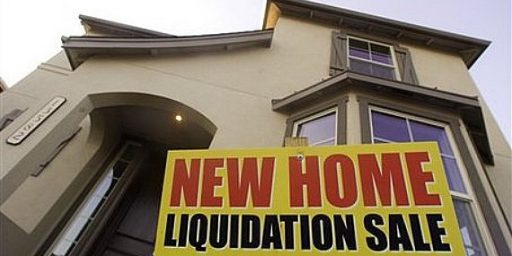Edward Gleaser on Housing Subsidies
They were a bad idea before this mess, and they are a bad idea now.
America’s housing woes are, in part, the legacy of government policies that pushed consumers to borrow and banks to lend. The home mortgage interest deduction encouraged people to make leveraged bets on housing, which looks silly today amidst the wreckage of over-hyped housing markets. Since the New Deal, the federal government has thought that it was a nifty idea to use its borrowing power to encourage home buying through government-sponsored agencies like Fannie Mae and Freddie Mac. The political beauty of such policies was that they subsidized borrowing and buying in a way that could be kept off the balance sheet. For years, policy makers maintained the fiction that Freddie and Fannie didn’t cost taxpayers anything.
One of the clearest lessons of the past year is that these lending policies are anything but cheap. To get banks to lend at below-market rates, the government must insure mortgages against default. When those mortgages do default, as they have in droves over the past two years, taxpayers are on the hook. Ordinary taxpayers are currently facing the prospect of paying for the last rash of government-subsidized lending. No one should be thrilled at the idea of a new government guarantee program that makes us liable for billions, or trillions, of dollars of new, bad mortgages.
Moreover, any benefits from a new round of subsidized lending are likely to be small. Over the past 25 years, when interest rates fell by 1 percent, housing prices increased by 4.6 percent. If this historical relationship continues to hold, the proposed plan would increase prices by about 5.25 percent. This modest increase would be barely noticeable at the epicenters of the housing bust where prices have fallen by over 30 percent. In many of those areas, like Las Vegas and Phoenix, land is cheap and building is unrestricted, and no credit market intervention in the world will keep housing prices permanently above the costs of supplying homes.
In fact, the government shouldn’t really be in the business of making housing more expensive at all. Price supports are usually a bad idea, because they distort supply decisions and redistribute from buyers to sellers. Why, exactly, should the government be encouraging more overbuilding in Las Vegas? Why, in an age of global warming, should the government subsidize more McMansions? Some economists argue that price supports are needed because prices are below fundamentals, but prices today remain significantly higher than either historical norms or supply costs.





I’m wondering about that myself, or more specifically, why they do it in the retarded way they do. Wouldn’t it be easier just to offer some type of subsidized credit (sort of like with student loans) to people who have a decent credit rating so they can have the deposit to put down for an apartment, then allow people to do the same with a down-payment for a house (with a stricter credit rating requirement)? That way, people would only be able to get a a house if they could actually afford the monthly payments; all the loan would do is help get them past the purchasing expenses hump, like the down payment and closing costs.
I’m speaking from personal experience – my mom had a decent credit rating and enough monthly income to make the payments once she was in the house we ultimately got, but hadn’t had enough discretionary income in the past to put aside to pay for the closing costs and down payment. We managed to get the house because one of my uncles is a real-estate agent, and he generously did the closing costs related stuff for no charge, while lending us the money for the down payment.
Plus, you could give the Housing Department to refuse the loan help to anyone wanting to buy a house in a certain areas with bad indicators (like extremely high property values, high stress of water supplies, high risk of fire, etc).
The housing boom really took off around 1997:
http://www.1stmillionat33.com/posts/06-09-12/house_his.gif
The GSEs (Fannie & Freddie) were decreasing their sub-prime mortgages in this period.
http://real-estate-and-urban.blogspot.com/2008/09/charles-calomiris-and-peter-wallis.html
Hence, the opening line: “America’s housing woes are, in part, the legacy of government policies that pushed consumers to borrow and banks to lend.” Should read “… in small part…”.
Now consider Richard’s point (supported by Treasury data) that “The loan performance on Fannie’s book of business is substantially better than the overall mortgage market.” And this argument is pretty clearly a straw man.
Joust on Don Quixote, joust on.
Really? I don’t see that as necessarily being true based on the graph.
1. The graph is only up to 2004,
2. The graph is only for mortgages in general from what I can see.
The title of the chart is “Holdings of Mortgage Debt Outstanding by Type of Institution”.
And looking at your first link there was clearly a housing boom in the early 1980’s which fits with what Gleaser notes about a 25 year period.
And I see no Treasury data in any link. I see Fed data, but no Treasury data, and certainly no data on performance.
I think the case when examined always goes back to the private mortgage makers, competing with looser standards, and passing along the hot potato (bad loans) before the sh*t hit the fan.
I think the Wikipedia page is a pretty fair round-up.
BTW, I’ve been for unwinding housing subsidies, including the mortgage interest rate tax deduction, and the housing capital gains loophole, for years. What we need(ed) was uniformly low taxes, not a hodge-podge of special gifts.
The question now is whether rejecting the “bad” is inviting the “worse.” I read this morning that 10% of current mortgage holders are behind or in foreclosure. To say that’s huge is an understatement.
Without a good path it would be nice to know the least bad.